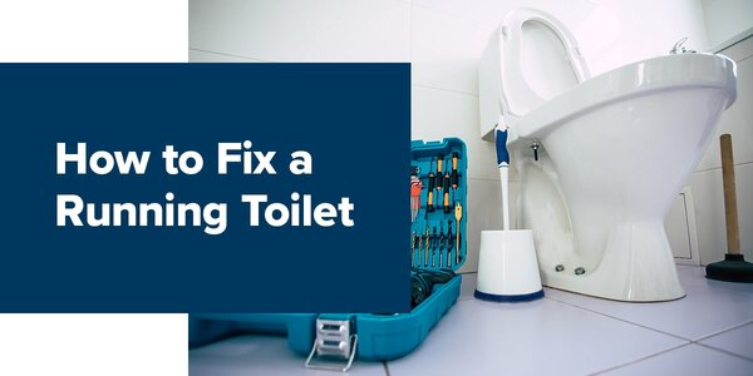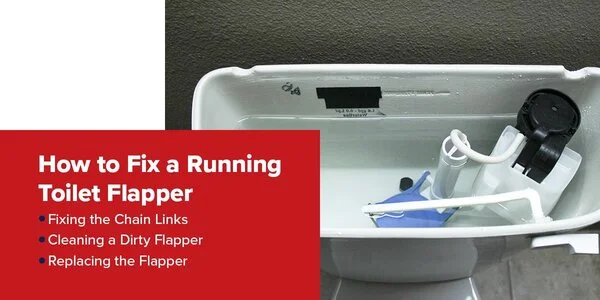
If your home or building has signs of a constantly running toilet, you may wonder how to fix a toilet that runs. Whether you need to replace the fill valve or look at the different ways to clean a toilet flapper, it may be time to consider new parts to fix that leaking toilet.
Why Is My Toilet Running?
Your toilet may be running for several reasons. The toilet flapper may be dirty, broken, and brittle, or the fill tube and valve may not work correctly. It may be a good idea to check all these areas of the toilet to ensure that you've fixed every part that could cause a leak.
Turn off the Water Supply
The first step to fixing a running toilet is turning off the water supply. Usually, you or a plumber can do this by finding the small knob on the wall near the toilet's right side. After turning this knob clockwise to the right, the valve will close, allowing you to turn off the water in the tank. Turning the knob counterclockwise enables you to turn the water back on.
After shutting off the water supply, you can remove the ceramic lid on top of the tank and gently lower it to a resting spot. Because the cover is often very fragile, consider placing it on a spare towel or blanket to prevent it from breaking.
Look inside the tank and familiarize yourself with the toilet's water control components. These are:
- The flush valve: Flush valves often have a hollow cylinder design made of plastic mounted to the bottom of the tank in a vertical direction.
- The fill valve: The fill valve allows water to pass into the toilet tank, controlling whether the water level rises or lowers.
- The fill tube: A fill tube accepts water that comes through the fill valve to refill the water in the tank. This mechanism keeps the toilet from overflowing.
- The toilet flapper: Made of rubber or silicone, the flapper helps seal the area and prevent leaks.
- The toilet float: The toilet float rises and lowers along with the water level. A lowered float opens the fill valve, and a float that rises stops the water from running.

How to Fix a Running Toilet Flapper
Defective flappers may cause a continuous leaking toilet issue. When you flush the toilet, the flapper acts as a rubber stopper inside the tank. The flapper lifts to release water into the toilet bowl, then closes to keep new water in the tank. This rubber stopper can deteriorate over time, collect dirt and debris or become too brittle to work correctly, causing water to leak past the seal.
To test the toilet flapper, push the flapper down to check if the water stops running. The flapper may not be the issue if the water continues to run. However, if the water stops running after you push the flapper down, it may be time to find a replacement mechanism.
Fixing the Chain Links
The chain links that attach the toilet flapper to the flush arm may need to be adjusted. You can add or remove links to create an appropriate length that helps pull the flapper upwards. If there is too much tension along the chain links, you can improve the mechanism by removing the hook that attaches to the chain and moving the hook up a few links. After changing the placement of the hook, you can reattach it to the flush lever.
Perhaps the chain link gets caught under the valve and creates a flimsy flush handle. While those in your home or business may be able to fidget with the handle and eventually get it to flush, this may not be a long-term solution. Try using a wire cutter to trim a few links away and reattach the hook to a new link. If the chain link is too short, you may need to add a few links to let the flapper close fully.
Cleaning a Dirty Flapper
Some flappers collect mineral deposits or debris, and others warp or disintegrate over time. While you can often remove minerals from the flapper, you should replace a discolored or worn flapper immediately. To inspect the flapper for mineral deposits, unhook the sides from the bottom pins attached to the overflow tube. The overflow tube is an open tube located in the tank's center.
After unhooking the flapper, look for any deposits that may have built up on the mechanism. A significant build-up will prevent the toilet from sealing and cause leakage. Vinegar is a natural cleaner, so try soaking the flapper in a bowl of vinegar for several minutes until the deposits disintegrate. You can scrub the remaining debris with a brush or toothbrush or wipe down the flapper with baby shampoo on a rag. Baby shampoo will clean the flapper and add another layer of elasticity to the rubber.
Replacing the Flapper
After cleaning the flapper or buying a new one, you can replace the flapper by first shutting off the water and draining the toilet. Many new flappers come with specific instructions to follow for installing the mechanism. Be sure you get a flapper that will fit your toilet, or look for a universal flapper that works with most toilets. Reattach the flapper by attaching the hooks to the pins on the overflow tube. You can test the flapper by turning the water back on to ensure it works.
How to Fix a Running Toilet Fill Tube
If the fill tube stops working, try pressing down on the flapper to see whether it contains the water in the tank. The fill tube is a plastic tube attached to the fill valve, which connects to the overflow pipe. A fill tube helps drain extra water out of the tank, but your toilet could start leaking if the mechanism stops working.
Look under the ceramic lid and locate the fill tube. If the mechanism is underwater, that may mean you need to cut back the water supply. The fill tube should remain above water, or it could lead to an overflow of running water. Try trimming the tube until it sits above the water line. This adjustment should stop any excess leaking.
How to Fix a Running Toilet Float
Every fill valve also has a float that rises and lowers along with the current water level. The water's height and the float tell the fill valve to shut off when the tank is full. If the water level lowers, so does the float. There are two different types of floats:
- Ball floats: This is a float with a long arm that attaches to the fill valve. Often this mechanism is shaped like a rubber ball.
- Cup floats: Cup floats are small and circular, wrapped around the fill valve's body in a cylinder. The cup float slides up and down the fill valve shaft to communicate water levels.
When the water level is too high, the toilet overflows. A broken ball or cup float may also cause a chain reaction where the tank never stops trying to drain water in or out of the tank. You or a plumber can often fix the ball float simply by bending the arm in the desired direction. A cup float may need extra adjustments. Usually, you can slide it back down the central tube to ensure it stays in the correct place.
How to Fix a Running Toilet Fill Valve
If you've checked the flapper, fill tube, and ball float and the problem isn't with any of those parts, the fill valve may be at fault. Drain the tank and take the fill valve out of the tank. Removing this part requires you to unscrew both the lock nut and the water supply line to remove the mechanism correctly.
When you need to buy a new fill valve, try taking the old one with you to the store to find a similar one to fit your needs. Once you have installed the new fill valve, adjust the float within the valve to your desired water level. The replacement should fix any leaking issues.


